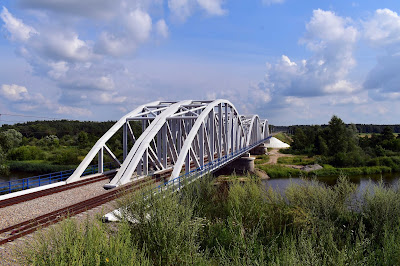It occurred to me one morning as I took an early stroll around my acre of land in Jakubowizna, that I didn't just buy land - I bought somewhere in the region of a million plants. Think of each individual grass plant or weed, a few hundred growing to the square metre. Some of these plants give fruit (apples, cherries, wild strawberries, plums, raspberries, blackberries), some flower nicely, some sting or prick (nettles, thistles, brambles), some carpet the ground (grasses). Some are big trees, some are seedlings or saplings - I decide which ones will grow into mighty oaks, and which should be pruned back. I decide which weeds to pull up, and which to leave unharmed. As well as the plants, there are also the insects - maybe a similar order of magnitude. Ants, spiders, flies, gnats. My decisions should be carefully taken, balancing environmental and aesthetic considerations.
Lawns are bad for the environment. They are aesthetically pleasing - indeed, they are a powerful reminder of 1950s America, a symbol of good times, when materialist plenty didn't have to be tempered by environmental concerns. Petrol-engined lawn mowers keeping those individual grass plants short, then rolled this way then that to give those distinctive stripes. The cost to the environment of hundreds of millions of lawns world wide is immense. Consider the grass plant itself. Capable of producing several leaves (or blades), as well as reproducing daughter plants nearby, it does its bit for the environment by absorbing carbon dioxide and releasing oxygen. And think of the energy (typically fossil fuels) used to cut it. An eight-inch blade of grass is four times as useful to the environment as one that's been cut back to two inches.
Lawns are symbolic of man's taming of nature - bending the environment to man's will. They exact a heavy price on us all. My neighbours mostly keep their large lawns short and tidy - it pleases the eye, but I worry about the climate. The pattern is there - hotter summers, more convection rainfall, intense deluges, flash-floods. Yes, they used to happen before, but they are far more common occurrences today. When was the last time 177 people died as a result of heavy rains in Germany, as happened earlier this month? [Answer - 1910; around 200. This Wikipedia list shows clearly how destructive heavy rains are occurring with increasing frequency in Europe.]
There's a clear correlation between increasing concentration of CO2 in the atmosphere and the frequency and intensity of floods, heat waves and drought periods. How we look after our land is an important factor. Decisions have to be taken, how to live.
The grass immediately surrounding my house is kept reasonably short using only a scythe. This limits the amount I can - and I want - to mow. Paths are kept open - to the garden tap, to the fruit trees and bushes. The gravel drive is kept as free of weeds as possible - not using herbicides, but by me uprooting the weeds as they start to grow big enough to pull out easily. Until then, they just grow, naturally.
 |
| Grass plant, uprooted from drive, awaits replanting |
By not using petrol to mow or weed-killer - or indeed pesticides - I am keeping the działka as chemical-free as possible. This is a policy decision. My vista, as I write these words, is of a meadow full of flowers and tall grasses, rather than a neatly-kept lawn. Apples ripen on a row of trees, unsprayed.
 |
| The back garden, untamed. |
There's 7.9 billion of us. Each one takes personal decisions that impact the environment and climate. I cannot stress enough the responsibility each one of us bears for ensuring that our impact on the planet is minimal. Each decision - whether or not to buy something, where that something comes from (near or far), how much we drive, how much we fly, what we eat.
On the działka, life is predicated by eating, eating by shopping, and shopping by walking - the trip to the shop/s is nearly always on foot. I therefore buy no more than I can comfortably carry in my rucksack for half an hour, enough food for up to two days. Rubbish is dutifully sorted, with anything compostable returning to the soil. Cooking requires gas for the rings - this comes in a bottle, which is still the original one from 2018! I use the gas as sparingly as possible. Cooking rice or lentils entails boiling half a kettle of water, soaking the rice or lentils in boiled water for five minutes or so, which halves the amount of time needed over the gas hob. One day, the gas will run out - and it will be while I'm cooking lunch or supper. Then I'll have the problem of getting it to one of many refill points for a top-up.
All in all, I have intended to make life on the działka as eco-friendly as possible, taking the greatest of care to minimise my eco-footprint.
This time last year:
The cost of Covid complacency
Ahead of the Big Day
This time five years ago:
Once in a blue moon
This time seven years ago:
A return to Snowdon - Wales' highest peak
This time eight years ago:
On the eve of Warsaw's Veturillo revolution
This time ten years ago:
Getting ready for the 'W'-hour flypast
This time 11 years ago:
A century of Polish scouting






























